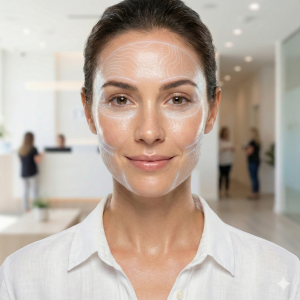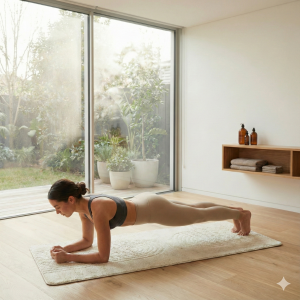Hello! As an aesthetics professional, I spend my days focusing on skin health, not just skin beauty. And over the years, one of the most powerful connections I’ve observed is the profound link between what you eat, how your body processes it, and the structure of your skin. It all boils down to a process called glycation, and today, I want to introduce you to a concept we use in our clinic: The Glycemic Load of Your Skincare Routine.
You already know about the Glycemic Index (GI) for food—it measures how quickly a carbohydrate raises your blood sugar.1 High-GI foods cause a spike, a crash, and chronic inflammation. But what if I told you that your carefully selected skincare products could be causing a similar “spike” in damage to your skin’s vital structures?
The Silent Killer: Glycation and the Collagen Catastrophe
Let’s start with the science of what happens when you have too much sugar in your diet. Excess glucose in your bloodstream attaches to proteins and lipids without the help of an enzyme. This process is called Advanced Glycation End-products (AGEs).2 Think of AGEs as sticky, rigid molecular handcuffs. When they bind to the most abundant protein in your skin—collagen—they cause it to become stiff, brittle, and cross-linked.3
This is why, in many of our initial consultations, we see a distinct type of aging on clients with a history of high sugar intake. It’s not just fine lines; it’s a loss of youthful plumpness, a dull, somewhat yellowed tone, and a noticeable decrease in the skin’s natural springiness.4
A Quick Anecdote: I had a client, Sarah (in her early 40s), who was meticulous about her topical anti-aging products but still showed significant skin laxity and a tired complexion. Her breakthrough moment came when we looked at her diet. Once she dramatically reduced her intake of high-GI foods and processed sugars, the results from her clinical treatments accelerated. Her skin tone brightened, and the elasticity improved noticeably within three months. We realized her previous diet was essentially undoing the hard work of her skincare regimen.
Introducing the Skincare “Glycemic Load”
The concept of the “Glycemic Load” of your skincare routine is a creative parallel, but it’s powerful. It suggests that just as high-GI foods cause AGEs, certain skincare ingredients can cause a rapid, damaging reaction that compromises the health and longevity of your collagen framework.
These are ingredients that strip, inflame, or chronically irritate the skin barrier, creating a state of low-grade, persistent damage that encourages the breakdown of collagen and elastin. They don’t technically cause glycation, but they create a destructive environment with a similar negative effect on your skin’s structural proteins.
🛑 High Glycemic Load Skincare Ingredients to Watch Out For:
- Harsh, High-Concentration Denatured Alcohols (often listed as ‘Alcohol Denat.’): While not all alcohols are bad, high concentrations of the drying variety can aggressively strip the skin’s natural lipid barrier.5 This leads to chronic inflammation, dehydration, and a cycle of skin stress that ultimately degrades collagen.
- Excessive, Overly Harsh Physical Exfoliants: Think large, jagged particles like crushed nuts or fruit pits. They create micro-tears in the skin, initiating a constant ‘wound-healing’ response. This perpetual state of micro-trauma puts stress on the deeper dermal layers and can hinder long-term collagen production.
- Astringent/Stripping Sulfates in Cleansers: Over-cleansing with harsh foaming agents (like Sodium Lauryl Sulfate) can compromise the skin’s microbiome and barrier function. A damaged barrier means chronic exposure to irritants, and chronic irritation is a known driver of premature aging.
The Actionable Insight: If your skin feels tight, red, or stinging after applying a product, that product has a high “glycemic load.” It’s spiking your skin’s stress response.
The Low Glycemic Load Approach: Supportive Ingredients
The goal of a healthy skincare routine is not to constantly fight a fire, but to build a robust, resilient structure. We want a routine that is low-glycemic—one that supports the skin’s natural processes without causing spikes in stress or inflammation.
✅ Your Low Glycemic Load Skincare Shopping List:
- Antioxidants (The Anti-AGEs Fighters): Vitamins C and E, Ferulic Acid, and Green Tea Extract are crucial. They don’t just protect against UV damage; they actively interfere with the glycation process, shielding your collagen from binding with sugar.
- Barrier Repairers (The Stabilizers): Look for ingredients like Ceramides, Niacinamide (Vitamin B3), and Hyaluronic Acid. These strengthen the skin’s lipid barrier, reducing inflammation and ensuring that external stressors cannot penetrate easily. Niacinamide, in particular, has been shown to improve the production of ceramides and stabilize the skin.6
- Collagen Supporters (The Builders): Retinoids (Retinol, Tretinoin) remain the gold standard.7 They communicate directly with skin cells, prompting them to produce new, healthy collagen. Bakuchiol is an excellent natural alternative for sensitive skin.8
Your Blueprint for Lasting Skin Health
Achieving truly glowing, resilient skin requires a dual approach: a low-GI diet and a low “glycemic load” skincare routine.
- Diet First: Reduce refined sugars, white bread, and excessive alcohol.9 Focus on whole foods, lean proteins, and healthy fats.
- Skincare Audit: Ditch the harsh, stripping cleansers and toners. If a product promises a painful ‘burn’ for quick results, it’s probably doing more harm than good in the long run.
- Prioritize Professional Intervention: If you are already seeing the effects of chronic glycation—skin laxity, deep lines, and a dull tone—topical products can only do so much. This is where we come in.
At The Face & Body Clinic, we assess your skin structure at a clinical level. We offer treatments like Radiofrequency Microneedling and Advanced Laser Therapies that bypass the compromised surface and stimulate deep, lasting, new collagen production.10 We are effectively pressing the ‘reset’ button on your collagen framework, making the path easier for your low “glycemic load” routine to maintain the results.
Don’t let your skincare routine be the high-sugar snack that secretly damages your most valuable protein. Switch to a supportive, low-glycemic approach today. Your collagen—and your future self—will thank you.




